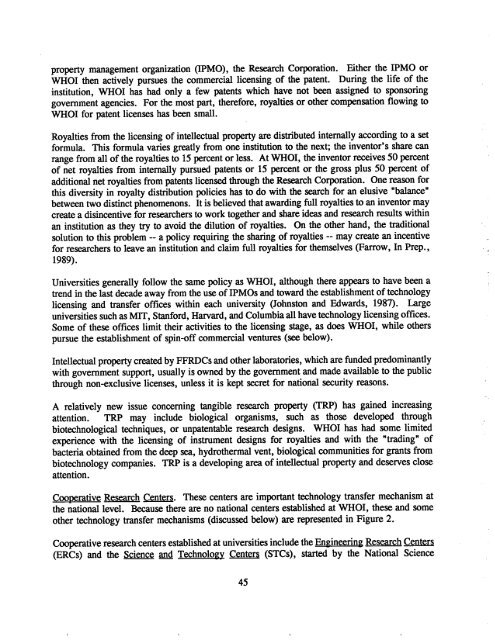WHOI-90-52
WHOI-90-52
WHOI-90-52
You also want an ePaper? Increase the reach of your titles
YUMPU automatically turns print PDFs into web optimized ePapers that Google loves.
property management organiztion (IPMO), the Resech Corpration. Either the IPMO or<br />
<strong>WHOI</strong> then actively pursues the commercial<br />
licensing of the patent. During the life of the<br />
institution, <strong>WHOI</strong> has had only a few patents which have not ben assigned to sponsoring<br />
government agencies. For the most par, therefore, royalties or other compensation flowing to<br />
<strong>WHOI</strong> for patent licenses has been smalL.<br />
Royalties from the licensing of intellectual propert are distrbute internally according to a set<br />
formula. This formula vares greatly from one institution to the next; the inventor's share ca<br />
range from all of the royalties to 15 percent or less. At <strong>WHOI</strong>, the inventor recives 50 percent<br />
of net royalties from internally pursued patents or 15 percent or the gross plus 50 percent of<br />
additional net royalties from patents license through the Resech Corpration. One reason for<br />
ths diversity in royalty distrbution policies has to do with the sech for an elusive "balance"<br />
between two distict phenomenons. It is believed that awarding full royalties to an inventor may<br />
create a disincentive for resechers to work together and share idea and resech results within<br />
an institution as they tr to avoid the dilution of royalties. On the other hand, the traditional<br />
solution to this problem -- a policy requiring the sharng of royalties -- may create an incentive<br />
for resechers to leave an institution and claim full royalties for themselves (Farow, In Prep.,<br />
1989). .<br />
Universities generay follow the sae policy as <strong>WHOI</strong>, although there appes to have been a<br />
trend in the last decde away from the use of IPMOs and toward the establishment of tehnology<br />
licensing and trsfer offices within each university (Johnston and Edwards, 1987). Lage<br />
universities such as MI, Staford, Harard, and Columbia all have tehnology licensing offces.<br />
Some of these offices limit their activities to the licensing stage, as does <strong>WHOI</strong>, while others<br />
pursue the establishment of spin-off commercial ventures (se below).<br />
Intellectual property created by FFRDCs and other laboratories, which are funded predominantly<br />
with government support, usually is owned by the government and made available to the public<br />
through non-exclusive licenses, unless it is kept seret for national seurity reasons.<br />
A relatively new issue concerning tagible resech property (T) has gained increasing<br />
attention. TR may include biologica organisms, such as those develope through<br />
biotechnologica techniques, or unpatentable resech designs. <strong>WHOI</strong> has had some limited<br />
experience with the licensing of instrment designs for royalties and with the "trding" of<br />
bacteria obtaned from the deep se, hydrothermal vent, biologica communities for grats from<br />
biotechnology companies. TR is a developing area of intellectua propert and deserves close<br />
attention.<br />
Cooperative Resech Centers. These centers are importt tehnology transfer mechanism at<br />
the national leveL. Beuse there are no national centers established at <strong>WHOI</strong>, these and some<br />
other technology trsfer mechanisms (discusse below) are represented in Figure 2.<br />
Cooperative resech centers established at universities include the Engineering Reseach Centers<br />
(ERCs) and the Science and Technology Centers (STCs), sta by the National Science<br />
45
















